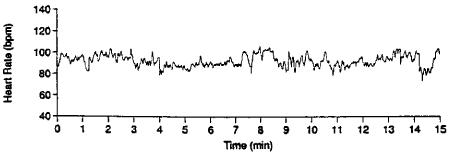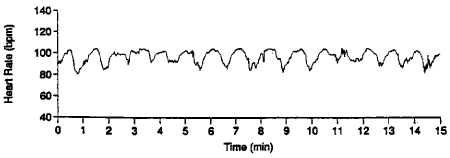|
The Dynamics of Living Systems:
Restoring Health in Individuals, Families and Organizations
Digest of a presentation by Ary Goldberger, M.D.
Monday, April 26, 1999
Answers the questions:
- What insights can we draw from biological systems
to help us understand organiza-tions?
- Why should we embrace random complexity and avoid
order and regularity?
From The Operating Room to the Board Room
“What is a cardiologist doing talking about organizations?” When Dr.
Goldberger poses this self-referential question at the beginning of
his presentations, he does so rhetorically. But it is an important question,
as it evokes the cross-disciplinary nature of complexity sciences, which
brings biologists, mathematicians, economists and management theorists
together in a rich shared dialogue. And, as it turns out, there is plenty
to learn about organizations from this Harvard professor of medicine
and pioneering cardiologist.
To illustrate, Goldberger asks another question: What
makes a healthy organization? He offers these three features:
- It is productive: The
organization subsystems work in concert to generate an output.
- It is innovative: The
organization is capable of creating novelty; something that didn’t
exist before.
- It is resilient: The
organization is able to change and adapt quickly to an unpredictable
environment.
Goldberger is quick to make the connection: these are
equally important characteristics of healthy organisms. To learn from
Dr. Goldberger is to shift constantly and seamlessly between the worlds
of physiology and corporate work in a democratic search for insight.
Leaping across disciplines in this way is consistent
with the principle of poly-scopic analogy. Simply put, understanding
complex systems at one level (e.g., individuals) can give insights into
apparently unrelated systems at lower or higher levels (such as institutional).
Many doctors still refuse to accept that we can apply these learnings.
But Goldberger insists: organizations are organisms. Consider the shared
dynamics between malnutrition in a cell and a corporation managing with
inadequate resources; or between a severed nerve and the stunted information
flow between members members of the organization.
Nonlinear Dynamics in a Nutshell
Ross Perot used to talk about “opening the hood of
the government” and fixing what’s wrong. It is certainly an appealing
idea that the offending piece could be removed, tinkered with and then
replaced for — presto! — a new, efficient government. But common sense
(and history) tell us that it isn’t so easy.
This is an example of a linear world view, which is
at odds with what has been learned from the study of nonlinear dynamics.
Compare the two:
- The linear world view assumes proportionality.
That is, the output is the same as the input, like turning a knob
that proportionally changes the results.
- Nonlinear dynamics demonstrates that output is
not proportional to input. Rather, systems
exhibit abrupt changes, chaos, and fractal organization.
- The linear world view assumes superposition.
That means the global behavior equals the sum of the parts.
- Nonlinear dynamics demonstrates that superposition
rarely applies. In complex systems the parts
of the whole interact in unpredictable ways, which leads to behavior
that is greater than – or even different from – the sum of the parts.
So is your world linear or nonlinear? You decide:
- If it is linear: Things
add up neatly; input and output are proportional; things are predictable
with no surprises.
- If it is nonlinear:
There are “emergent” properties, where the whole does not equal the
sum of the parts; small changes can lead to huge effects; things are
unpredictable, and things appear to happen randomly.
Chaos is just one part of nonlinear dynamics
that refers to the complicated behavior that occurs in very simple systems.
It has been demonstrated that very simple equations can create extremely
complex outputs. But within this resulting chaos lies a deeper and hidden
order.
What’s a Fractal, Anyway?
Much has been said about fractals. You have probably seen the photos
and pulsating computer screen savers. But what is the relevance of all
of this?
Simply, a fractal is a treelike object composed
of subunits that resemble the larger scale structure. One example is
a fern, in which individual leaves resemble the larger plant. This internal
look-alike prop erty is known as self-similarity or scale invariance.
The network of veins and arteries in your body is fractal
in structure. So is a head of broccoli, a tree, a mountain range, clouds,
the folds in the human brain and coral reef. In fact, much of what we
find pleasing in nature is fractal. Turbulence is one of the most complicated
subjects in physics, but it has been discovered that it too is fractal.
Mountain ranges are also fractal.
There is a paradoxical quality of fractals. If you
consider a coastline (which is fractal) from a satellite photo, you
could estimate its approximate length. But if you were to move in for
closer and closer views you would begin to see more bays and peninsulas
that, when measured, increase the length of the line. This continues
to be true as you move in at closer and closer levels. The more small-scale
detail you pick up, the longer the line becomes. The smaller the ruler,
the longer the line!
A fractal line is not one dimensional, because it isn’t
really straight. Isn’t two-dimensional, because it doesn’t fill a plane.
It can’t be thought of in Euclidean terms at all; Really, a fractal
line is approximately 1 1/2 dimensional.
Fractal Aesthetics

Fractal self-similarity is pleasing in art. Fractal structure can be
seen in the spiney structure of medieval cathedrals, for example. Some
quilt designs are fractal, featuring large geometric patterns that are
also repeated in each of the quilt’s squares.
Classical music is fractal too. If you look at frequency
spectrum of a heartbeat, compared with fluctuations in pitch from Bach
concerti, they are virtually identical.
Why do we find classical music compelling? Is it possible
that artistic expressions are just externalizations of things that are
inside of us? Perhaps the root of artistic genius, Goldberger speculates,
is the ability to recognize biological patterns. It is the complexity
of the human spirit, which is physiological.
Shakespeare recognized this when he wrote: “Ecstasy!
My pulse, as yours, doth temperally keep time, and makes as healthful
music.”
Fractal Physiology and Health
Fractals aren’t just physical objects in space. They can be processes
in time, too.
Consider the heartbeat. A healthy heart rate fluctuates
in a manner consistent with fractal processes.(If you look at increasingly
closer scales, it remains wrinkly and irregular.)

Compare this with a rendering from a patient suffering
heart failure. There is a significant loss of complexity:

Thus, disease can be defined as a breakdown
of fractal structure, loss of complexity. The idea of decomplexification
of disease is where the output of systems becomes more regular.
The loss of variability creates breakdown. Disorder is actually
healthy! (Note that one can have too much of a good thing: A high degree
of randomness and irregularity can also result in breakdown and a loss
of complexity.)
The paradox is that patients with a wide range of disorders
often display predictable (ordered) dynamics. This can be observed in
heart attack (as illustrated above), Parkinson’s disease, obsessive
compulsive disorder, strokes and comas. Aging can be thought of as a
process of decomplexification too.
Why is it healthy to be chaotic/fractal?
- It creates variability that leads to a large repertoire
of responses.
- It gives the capability to cope in an unpredictable
envronment.
- Our system can’t be too organized, but it can’t
be too random either. A fractal structure is a nice in-between point.
The Final Big Questions How do you assess organizational health? Where
do you put the thermometer?
- How can we restore fractal chaotic-like complexity
to individuals?
- How can we restore this same property to organizations?
- Does your organization chart look like a tree, with
nested hierarchies, or do you basically have a bunch of middle managers
talking to themselves?
- How efficiently does information percolate throughout
the system? How varied is the repertoire of behaviors in the organization?
- Does your organization readily evoke new structures
to adapt to changes?
About the Presenter
Dr. Ary Goldberger graduated from Harvard College (A.B., summa cum
laude, 1970) and received his medical degree from Yale Medical School
in 1974. He was a medical intern and resident at Yale-New Haven Hospital,
1974-1977, and a cardiology fellow at the University of California at
San Diego, 1977-79. He remained at UCSD on the medical school faculty
until 1985. He is currently associate professor of medicine at Harvard
Medical School and clinical director of the Electrocardiography and
Arrhythmia Monitoring/Nonlinear Dynamics Laboratories at Boston’s Beth
Israel Deaconness Hospital.
Dr. Goldberger is the author of more than 100 papers
and two text-books on electrocardiography. He was the 1988 recipient
of the S. Robert Stone Award for excellence in teaching at Harvard Medical
School.
|